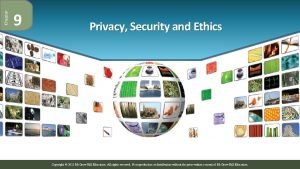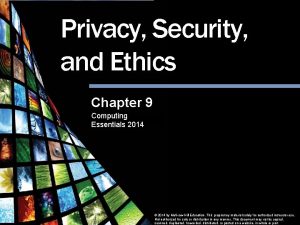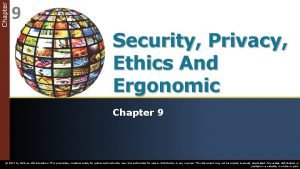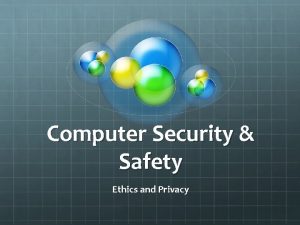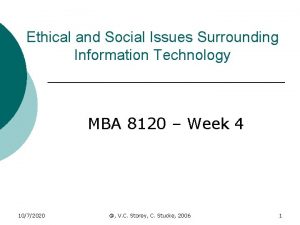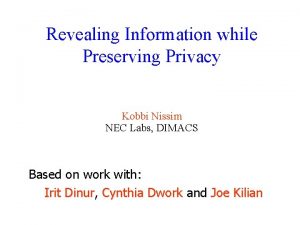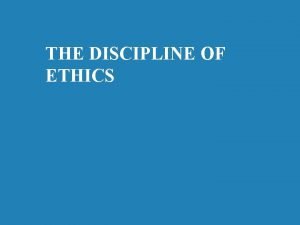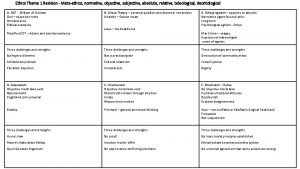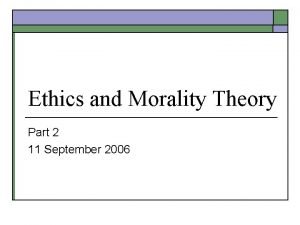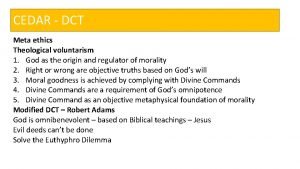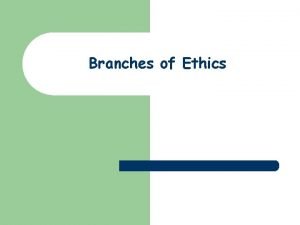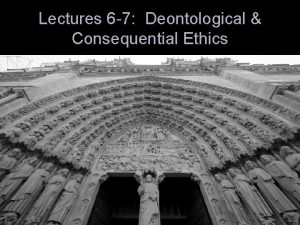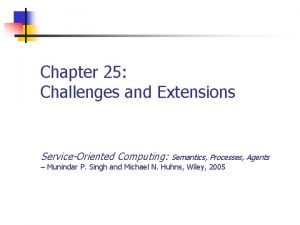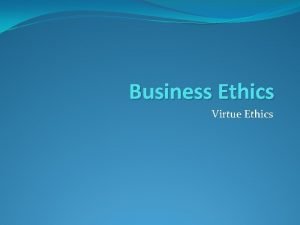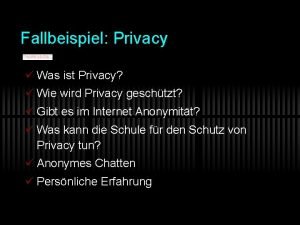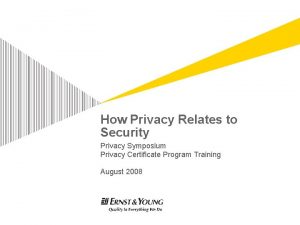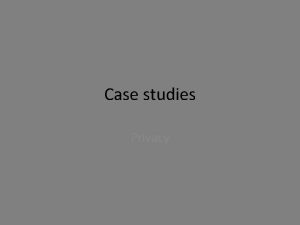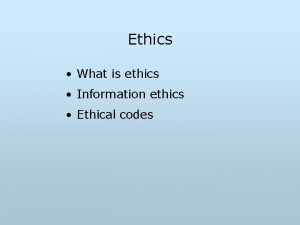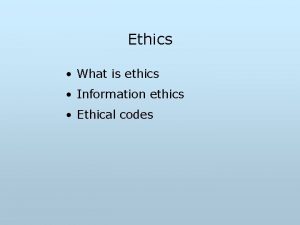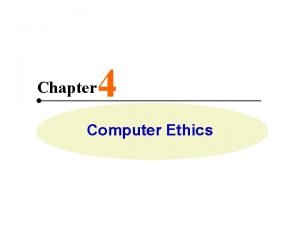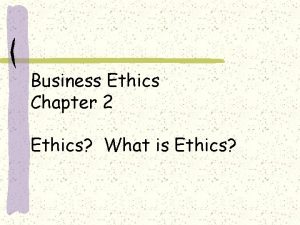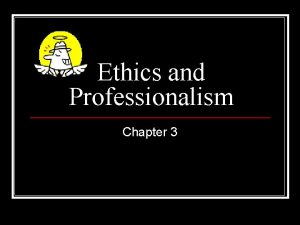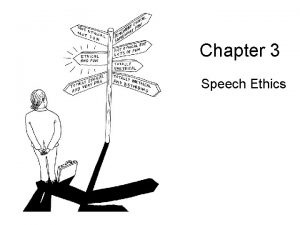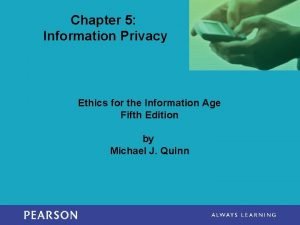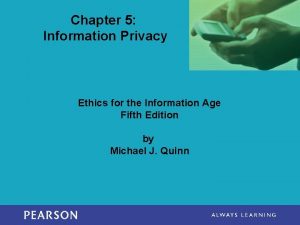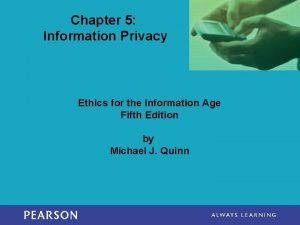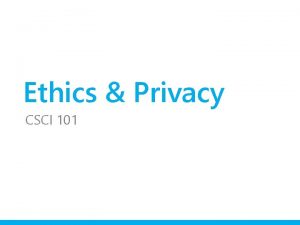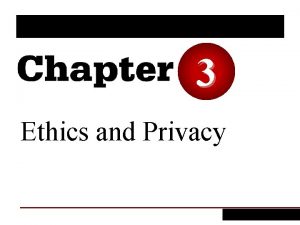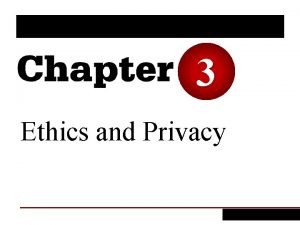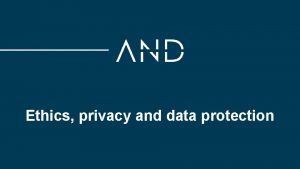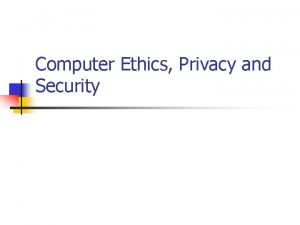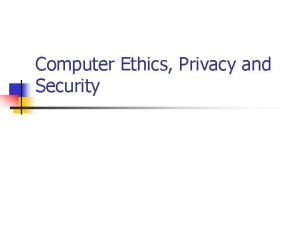Chapter 5 Information Privacy Ethics for the Information
















































- Slides: 48

Chapter 5: Information Privacy Ethics for the Information Age Fifth Edition by Michael J. Quinn

Chapter Overview • • Introduction Perspectives on privacy Information disclosures Data mining 1 -2 Copyright © 2013 Pearson Education, Inc. Publishing as Pearson Addison-Wesley 1 -2

5. 1 Introduction 1 -3 Copyright © 2013 Pearson Education, Inc. Publishing as Pearson Addison-Wesley 1 -3

Information Technology Erodes Privacy • Information collection, exchange, combination, and distribution easier than ever means less privacy • Scott Mc. Nealy: “You have zero privacy anyway. Get over it. ” • We will consider how we leave an “electronic trail” of information behind us and what others can do with this info 1 -4 Copyright © 2013 Pearson Education, Inc. Publishing as Pearson Addison-Wesley 1 -4

NON SEQUITUR © 2005 Wiley Ink, Inc. Dist. By UNIVERSAL UCLICK. Reprinted with permission. All rights reserved. 1 -5 Copyright © 2013 Pearson Education, Inc. Publishing as Pearson Addison-Wesley 1 -5

5. 2 Perspectives on Privacy 1 -6 Copyright © 2013 Pearson Education, Inc. Publishing as Pearson Addison-Wesley 1 -6

Defining Privacy • Privacy related to notion of access • Access – Physical proximity to a person – Knowledge about a person • • Privacy is a “zone of inaccessibility” Privacy violations are an affront to human dignity Too much individual privacy can harm society Where to draw the line? 1 -7 Copyright © 2013 Pearson Education, Inc. Publishing as Pearson Addison-Wesley 1 -7

Harms of Privacy • • Cover for illegal or immoral activities Burden on the nuclear family Hidden dysfunctional families Ignored people on society’s fringes 1 -8 Copyright © 2013 Pearson Education, Inc. Publishing as Pearson Addison-Wesley 1 -8

Benefits of Privacy • • • Individual growth Individual responsibility Freedom to be yourself Intellectual and spiritual growth Development of loving, trusting, caring, intimate relationships 1 -9 Copyright © 2013 Pearson Education, Inc. Publishing as Pearson Addison-Wesley 1 -9

Is There a Natural Right to Privacy? • Privacy rights stem from property rights: “a man’s home is his castle” • Coercive Acts before American Revolution led to 3 rd Amendment to U. S. Constitution • Samuel Warren and Louis Brandeis: People have “the right to be let alone” • Judith Jarvis Thomson: “Privacy rights” overlap other rights • Conclusion: Privacy is not a natural right, but it is a prudential right 1 -10 Copyright © 2013 Pearson Education, Inc. Publishing as Pearson Addison-Wesley 1 -10

Do People Have the Right to Be Left Alone? Phamous. Fotos / Splash News/Newscom 1 -11 Copyright © 2013 Pearson Education, Inc. Publishing as Pearson Addison-Wesley 1 -11

Privacy and Trust • Perhaps modern life is actually more private than life centuries ago – Most people don’t live with extended families – Automobile allows us to travel alone – Television v. public entertainment • Challenge: we now live among strangers • Remedy: establishing reputations – Ordeal, such as lie detector test or drug test – Credential, such as driver’s license, key, ID card, college degree • Establishing reputation is done at the cost of reducing privacy 1 -12 Copyright © 2013 Pearson Education, Inc. Publishing as Pearson Addison-Wesley 1 -12

Case Study: Secret Monitoring • Sullivans have a baby girl • Both work; they are concerned about performance of full-time nanny • Purchase program that allows monitoring through laptop’s camera placed in family room • They do not inform nanny she is being monitored 1 -13 Copyright © 2013 Pearson Education, Inc. Publishing as Pearson Addison-Wesley 1 -13

Rule Utilitarian Evaluation • If everyone monitored nannies, it would not remain a secret for long • Consequences – Nannies would be on best behavior in front of camera – Might reduce child abuse and parents’ peace of mind – Would also increase stress and reduce job satisfaction of child care providers – Might result in higher turnover rate and less experienced pool of nannies, who would provide lower-quality care • Harms appear greater than benefits, so we conclude action was wrong 1 -14 Copyright © 2013 Pearson Education, Inc. Publishing as Pearson Addison-Wesley 1 -14

Social Contract Theory Evaluation • It is reasonable for society to give people privacy in their own homes • Nanny has a reasonable expectation that her interactions with baby inside home are private • Sullivan’s decision to secretly monitor the nanny is wrong because it violates her privacy 1 -15 Copyright © 2013 Pearson Education, Inc. Publishing as Pearson Addison-Wesley 1 -15

Kantian Evaluation • Imagine rule, “An employer may secretly monitor the work of an employee who works with vulnerable people” • If universalized, there would be no expectation of privacy by employees, so secret monitoring would be impossible • Proposed rule is self-defeating, so it is wrong for Sullivans to act according to the rule 1 -16 Copyright © 2013 Pearson Education, Inc. Publishing as Pearson Addison-Wesley 1 -16

Summary • Three analyses have concluded Sullivans were wrong to secretly monitor how well their nanny takes care of their baby • Morally acceptable options – Conduct more comprehensive interview of nanny – More thoroughly check nanny’s references – Spend a day or two at home observing nanny from a distance – Be up-front with nanny about desire to install and use surveillance software on laptop 1 -17 Copyright © 2013 Pearson Education, Inc. Publishing as Pearson Addison-Wesley 1 -17

5. 3 Information Disclosures 1 -18 Copyright © 2013 Pearson Education, Inc. Publishing as Pearson Addison-Wesley 1 -18

Public Records • Public record: information about an incident or action reported to a government agency for purpose of informing the public • Examples: birth certificates, marriage licenses, motor vehicle records, criminal records, deeds to property • Computerized databases and Internet have made public records much easier to access 1 -19 Copyright © 2013 Pearson Education, Inc. Publishing as Pearson Addison-Wesley 1 -19

Records Held by Private Organizations • • Credit card purchases Purchases made with loyalty cards Voluntary disclosures Posts to social network sites 1 -20 Copyright © 2013 Pearson Education, Inc. Publishing as Pearson Addison-Wesley 1 -20

Data Gathering and Privacy Implications • • • Facebook tags Enhanced 911 services Rewards or loyalty programs Body scanners RFID tags Implanted chips On. Star Automobile “black boxes” Medical records Digital video recorders Cookies and flash cookies 1 -21 Copyright © 2013 Pearson Education, Inc. Publishing as Pearson Addison-Wesley 1 -21

Facebook Tags • Tag: Label identifying a person in a photo • Facebook allows users to tag people who are on their list of friends • About 100 million tags added per day in Facebook • Facebook uses facial recognition to suggest name of friend appearing in photo • Does this feature increase risk of improper tagging? 1 -22 Copyright © 2013 Pearson Education, Inc. Publishing as Pearson Addison-Wesley 1 -22

Enhanced 911 Services • Cell phone providers in United States required to track locations of active cell phones to within 100 meters • Allows emergency response teams to reach people in distress • What if this information is sold or shared? 1 -23 Copyright © 2013 Pearson Education, Inc. Publishing as Pearson Addison-Wesley 1 -23

Rewards or Loyalty Programs • Shoppers who belong to store’s rewards program can save money on many of their purchases • Computers use information about buying habits to provide personalized service – Shop. Rite computerized shopping carts with pop-up ads • Do card users pay less, or do non-users get overcharged? 1 -24 Copyright © 2013 Pearson Education, Inc. Publishing as Pearson Addison-Wesley 1 -24

Body Scanners • Some department stores have 3 -D body scanners • Computer can use this information to recommend clothes • Scans can also be used to produce custom -made clothing 1 -25 Copyright © 2013 Pearson Education, Inc. Publishing as Pearson Addison-Wesley 1 -25

Body Scanner Takes Measurements AP Photo/Richard Drew 1 -26 Copyright © 2013 Pearson Education, Inc. Publishing as Pearson Addison-Wesley 1 -26

RFID Tags • RFID: Radio frequency identification • An RFID tag is a tiny wireless transmitter • Manufacturers are replacing bar codes with RFID tags – Contain more information – Can be scanned more easily • If tag cannot be removed or disabled, it becomes a tracking device 1 -27 Copyright © 2013 Pearson Education, Inc. Publishing as Pearson Addison-Wesley 1 -27

Implanted Chips • Taiwan: Every domesticated dog must have an implanted microchip – Size of a grain of rice; implanted into ear – Chip contains name, address of owner – Allows lost dogs to be returned to owners • RFID tags approved for use in humans – Can be used to store medical information – Can be used as a “debit card” 1 -28 Copyright © 2013 Pearson Education, Inc. Publishing as Pearson Addison-Wesley 1 -28

On. Star • On. Star manufactures communication system incorporated into rear-view mirror • Emergency, security, navigation, and diagnostics services provided subscribers • Two-way communication and GPS • Automatic communication when airbags deploy • Service center can even disable gas pedal 1 -29 Copyright © 2013 Pearson Education, Inc. Publishing as Pearson Addison-Wesley 1 -29

RFID Tags Speed Inventory Process © Marc F. Henning / Alamy 1 -30 Copyright © 2013 Pearson Education, Inc. Publishing as Pearson Addison-Wesley 1 -30

Automobile “Black Boxes” • Modern automobiles come equipped with a “black box” • Maintains data for five seconds: – Speed of car – Amount of pressure being put on brake pedal – Seat belt status • After an accident, investigators can retrieve and gather information from “black box” 1 -31 Copyright © 2013 Pearson Education, Inc. Publishing as Pearson Addison-Wesley 1 -31

Medical Records • Advantages of changing from paper-based to electronic medical records • Quicker and cheaper for information to be shared among caregivers – Lower medical costs – Improve quality of medical care • Once information in a database, more difficult to control how it is disseminated 1 -32 Copyright © 2013 Pearson Education, Inc. Publishing as Pearson Addison-Wesley 1 -32

Digital Video Recorders • Ti. Vo service allows subscribers to record programs and watch them later • Ti. Vo collects detailed information about viewing habits of its subscribers • Data collected second by second, making it valuable to advertisers and others interested in knowing viewing habits 1 -33 Copyright © 2013 Pearson Education, Inc. Publishing as Pearson Addison-Wesley 1 -33

Cookies • Cookie: File placed on computer’s hard drive by a Web server • Contains information about visits to a Web site • Allows Web sites to provide personalized services • Put on hard drive without user’s permission • You can set Web browser to alert you to new cookies or to block cookies entirely 1 -34 Copyright © 2013 Pearson Education, Inc. Publishing as Pearson Addison-Wesley 1 -34

Flash Cookies • Flash cookie: File placed on your computer’s hard drive by a Web server running the Adobe Flash Player • Flash cookie can hold 25 times as much information as a browser cookie • Flash cookies not controlled by browser’s privacy controls • Some Web sites use flash cookies as a way of backing up browser cookies. If you delete browser cookie, it can be “respawned” from the flash cookie • Half of 100 most popular Web sites use flash cookies 1 -35 Copyright © 2013 Pearson Education, Inc. Publishing as Pearson Addison-Wesley 1 -35

5. 4 Data Mining 1 -36 Copyright © 2013 Pearson Education, Inc. Publishing as Pearson Addison-Wesley 1 -36

Data Mining • Searching records in one or more databases, looking for patterns or relationships • Can be used to profiles of individuals • Allows companies to build more personal relationships with customers 1 -37 Copyright © 2013 Pearson Education, Inc. Publishing as Pearson Addison-Wesley 1 -37

Google’s Personalized Search • Secondary use: Information collected for one purpose use for another purpose • Google keeps track of your search queries and Web pages you have visited – It uses this information to infer your interests and determine which pages to return – Example: “bass” could refer to fishing or music • Also used by retailers for direct marketing 1 -38 Copyright © 2013 Pearson Education, Inc. Publishing as Pearson Addison-Wesley 1 -38

Secondary Uses of Information 1 -39 Copyright © 2013 Pearson Education, Inc. Publishing as Pearson Addison-Wesley 1 -39

Collaborative Filtering • Form of data mining • Analyze information about preferences of large number of people to predict what one person may prefer – Explicit method: people rank preferences – Implicit method: keep track of purchases • Used by online retailers and movie sites 1 -40 Copyright © 2013 Pearson Education, Inc. Publishing as Pearson Addison-Wesley 1 -40

Ownership of Transaction Information • Who controls transaction information? – Buyer? – Seller? – Both? • Opt-in: Consumer must explicitly give permission before the organization can share info • Opt-out: Organization can share info until consumer explicitly forbid it • Opt-in is a barrier for new businesses, so direct marketing organizations prefer opt-out 1 -41 Copyright © 2013 Pearson Education, Inc. Publishing as Pearson Addison-Wesley 1 -41

Credit Reports • Example of how information about customers can itself become a commodity • Credit bureaus – Keep track of an individual’s assets, debts, and history of paying bills and repaying loans – Sell credit reports to banks, credit card companies, and other potential lenders • System gives you more choices in where to borrow money • Poor credit can hurt employment prospects 1 -42 Copyright © 2013 Pearson Education, Inc. Publishing as Pearson Addison-Wesley 1 -42

Microtargeting • Political campaigns determine voters most likely to support particular candidates – – Voter registration Voting frequency Consumer data GIS data • Target direct mailings, emails, text messages, home visits to most likely supporters 1 -43 Copyright © 2013 Pearson Education, Inc. Publishing as Pearson Addison-Wesley 1 -43

Marketplace: Households • Lotus Development Corporation developed CD with information on 120 million Americans • Planned to sell CD to small businesses that wanted to create mailing lists based on various criteria, such as household income • More than 30, 000 consumers complained to Lotus about invasion of privacy • Lotus dropped plans to sell CD 1 -44 Copyright © 2013 Pearson Education, Inc. Publishing as Pearson Addison-Wesley 1 -44

Facebook Beacon • Fandango, e. Bay, and 42 other online businesses paid Facebook to do “word of mouth” advertising • Facebook users surprised to learn information about their purchases was shared with friends • Beacon was based on an opt-out policy • Beacon strongly criticized by various groups • Facebook switched to an opt-in policy regarding Beacon 1 -45 Copyright © 2013 Pearson Education, Inc. Publishing as Pearson Addison-Wesley 1 -45

Netflix Prize • Netflix offered $1 million prize to any group that could come up with a significantly better algorithm for predicting user ratings • Released more than 100 million movie ratings from a half million customers – Stripped ratings of private information • Researchers demonstrated that ratings not truly anonymous if a little more information from individuals was available • U. S. Federal Trade Commission complaint and lawsuit • Netflix canceled sequel to Netflix Prize 1 -46 Copyright © 2013 Pearson Education, Inc. Publishing as Pearson Addison-Wesley 1 -46

Social Network Analysis • Data mining now incorporating information collected from social networks • Examples – Cell phone companies in India identify “influencers” – Police predict locations of big parties – Banks evaluate the riskiness of loans 1 -47 Copyright © 2013 Pearson Education, Inc. Publishing as Pearson Addison-Wesley 1 -47

Police Monitor Facebook and Twitter to Identify Locations of Big Parties © Allen Sullivan/ZUMA Press/Newscom 1 -48 Copyright © 2013 Pearson Education, Inc. Publishing as Pearson Addison-Wesley 1 -48
 Cvs privacy awareness and hipaa privacy training
Cvs privacy awareness and hipaa privacy training Chapter 9 privacy security and ethics
Chapter 9 privacy security and ethics Chapter 9 privacy security and ethics
Chapter 9 privacy security and ethics Chapter 9 privacy security and ethics
Chapter 9 privacy security and ethics What is the destructive event or prank the virus delivers
What is the destructive event or prank the virus delivers Social issues in information technology
Social issues in information technology Yehuda lindell
Yehuda lindell Descriptive ethics
Descriptive ethics Normative ethics
Normative ethics Macro and micro ethics
Macro and micro ethics Factual inquiry in ethics
Factual inquiry in ethics Methaethics
Methaethics Descriptive ethics vs normative ethics
Descriptive ethics vs normative ethics Discipline
Discipline Theological voluntarism
Theological voluntarism Metaethics vs normative ethics
Metaethics vs normative ethics Deontological ethics definition
Deontological ethics definition Teleological ethics vs deontological ethics
Teleological ethics vs deontological ethics Kontinuitetshantering
Kontinuitetshantering Typiska drag för en novell
Typiska drag för en novell Tack för att ni lyssnade bild
Tack för att ni lyssnade bild Ekologiskt fotavtryck
Ekologiskt fotavtryck Varför kallas perioden 1918-1939 för mellankrigstiden
Varför kallas perioden 1918-1939 för mellankrigstiden En lathund för arbete med kontinuitetshantering
En lathund för arbete med kontinuitetshantering Särskild löneskatt för pensionskostnader
Särskild löneskatt för pensionskostnader Tidbok
Tidbok Sura för anatom
Sura för anatom Densitet vatten
Densitet vatten Datorkunskap för nybörjare
Datorkunskap för nybörjare Tack för att ni lyssnade bild
Tack för att ni lyssnade bild Att skriva en debattartikel
Att skriva en debattartikel Delegerande ledarskap
Delegerande ledarskap Nyckelkompetenser för livslångt lärande
Nyckelkompetenser för livslångt lärande Påbyggnader för flakfordon
Påbyggnader för flakfordon Tryck formel
Tryck formel Publik sektor
Publik sektor Lyckans minut erik lindorm analys
Lyckans minut erik lindorm analys Presentera för publik crossboss
Presentera för publik crossboss Jiddisch
Jiddisch Plats för toran ark
Plats för toran ark Klassificeringsstruktur för kommunala verksamheter
Klassificeringsstruktur för kommunala verksamheter Fimbrietratt
Fimbrietratt Bästa kameran för astrofoto
Bästa kameran för astrofoto Centrum för kunskap och säkerhet
Centrum för kunskap och säkerhet Programskede byggprocessen
Programskede byggprocessen Mat för idrottare
Mat för idrottare Verktyg för automatisering av utbetalningar
Verktyg för automatisering av utbetalningar Rutin för avvikelsehantering
Rutin för avvikelsehantering Smärtskolan kunskap för livet
Smärtskolan kunskap för livet

